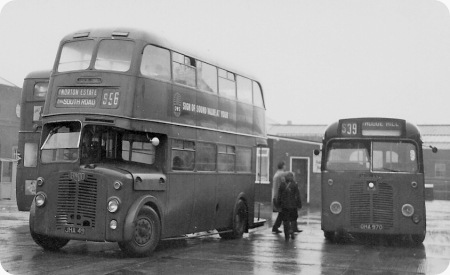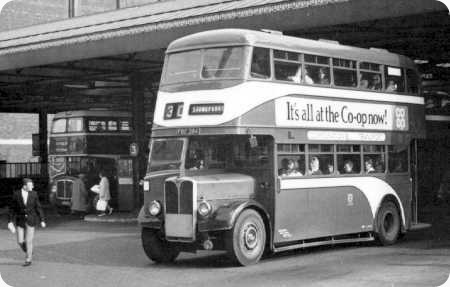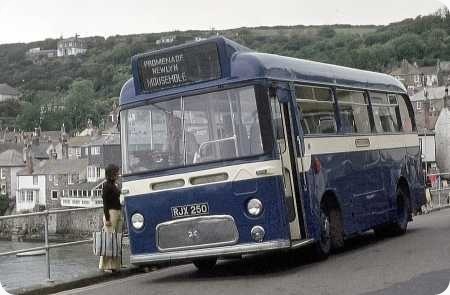Midland Red – AEC Regent II – JHA 49 – 3148

Photograph by ‘unknown’ if you took this photo please go to the copyright page.
Midland Red (Birmingham and Midland Motor Omnibus Co)
1948
AEC Regent II
Brush H30/26R
This photograph of Midland Red buses at Stourbridge bus station in the late 1950’s/early 1960’s, comes from my collection of postcards bought as an aide memoire of my early bus spotting holidays in the Hinckley area in the 1950s, when Midland Red (BMMO) was at the peak of their existence. The photographer is unknown, but the card is credited to the Midlands Omnibus Preservation Society, so perhaps someone may be able to gives us a name.
Midland Red was famous for its innovative bus designs. During a glorious period from 1938 until the mid-1960’s, BMMO introduced a stunning array of unique and efficient buses to serve their huge network of urban, suburban, inter-urban, country, express and tour operations. Ironically, their in-house activities eventually proved to be their downfall, as they couldn’t compete with commercial suppliers who eventually offered more economical (but less interesting) products.
3148 (JHA 49) was an AD2 – one of fifty AEC Regent II’s with Brush H30/26R bodies, delivered as late as 1948. These had the distinctive body style which was a direct development of the 1945 BMMO-engined prototype (D1). Once BMMO’s in-house manufacturing capacity became free, following large-scale, underfloor-engined, single-deck chassis manufacture, they were able to build the D5 chassis which bore an 8-foot wide version of the AD2 body (the designations D3 and D4 were never used).
3970 (OHA 970) was one of a large number of BMMO-engined S13’s from 1953 with DP40F bodies built by Carlyle, Brush and Nudd. It is wearing the distinctive red and black coach livery even though it is operating a local town service.
Just visible is the rear of one of the delightful, pre-war SOS FEDD’s (forward-entrance, double-decker).
Photograph and Copy contributed by Paul Haywood
———
02/05/12 – 17:25
Great to see my old Company featured, most of the articles feature the ‘Northerners’ and BMMO, the great innovators, largely ignored. With regard to Paul’s request the Birmingham Omnibus Preservation Society was formed by John A Searle and Paul Gray, the latter (I think) still has a connection with the late lamented ‘Aston Manor Museum’ which I am pleased to see has relocated after being so dreadfully treated by Birmingham City Council! "BOPS" was formed – in the early 70’s, ‘to purchase, or assist other suitable bodies to purchase, a small but representative selection of the remaining BMMO built vehicles’. I do hope Paul’s recollections spark many more memories of this unique operator and it’s many ground breaking PSV derivatives.
Nigel Edwards
———
03/05/12 – 09:06
Your comment, Nigel, struck a chord with me because, browsing through the site the other day, I too was struck by the absence of any Midland Red posting. Paul’s is the only one I’ve come across. BMMO were by far the largest provincial operator – about 3 times the size of the next largest company – so that’s odd, especially bearing in mind their extensive manufacturing activities.
I’ve sometimes wondered why BMMO vehicles never found their way to other, (particularly BET), companies. Was this deliberate Midland Red policy, was it lack of manufacturing capacity, (I think BMMOs were made in the old Bean factory), was it cost compared to alternatives, or were other operators just not interested?
Paul suggests that cost was a factor, and no doubt he’s right, but a larger market would have reduced unit costs and made BMMOs a more attractive proposition, surely? Considering how Bristol grew and flourished through Tilling support, were BMMO vehicles a lost opportunity? If they were as good as their fans claim, it might seem so.
Roy Burke
———
03/05/12 – 14:13
Don’t forget that Trent actually took a substantial fleet of SOS’s, but then went over to AEC Regals. I don’t know why, but BMMO just never "floated my boat". For one thing I never did like tin fronts. Mind you, I remember doing an aural double-take at Tamworth bus station one day, when one of these disguised AEC’s was started up and set off for "St Helena via Glascote", producing the delightful music of a crash-gearbox Regent, which was the last sound in the world I was expecting it to make.
Stephen Ford
———
03/05/12 – 14:14
In prewar days both Trent and Northern General bought BMMO designed vehicles. After the war I doubt if the BMMO factory could have kept pace with demand and in addition several of the designs were advanced mechanically and the British bus industry has always been conservative when it comes to innovation.
Chris Hough
———
04/05/12 – 07:16
Interestingly Stratford Blue who were a Midland Rad subsidiary were never tempted being happy with various members of the Leyland zoo.
Chris Hough
———
04/05/12 – 07:18
You’re right, Stephen and Chris, about the Trent and Northern General versions of the BMMO designs. However, this was during the pre-war era when Midland Red seemed archaic, and before the wonderful post-war period when GM Donald Sinclair turned BMMO into an industry-leading organisation.
My early memories of MR date from the mid-1950s and, although I was used to seeing underfloor-engined buses and "tin fronts" in Leeds, the style of bodywork of the AD2’s, D5’s, S6’s and S8’s was so different I found them fascinating.
I fondly remember the adventure of riding on one of the ONC pre-war coaches on the X69(?) from Hinckley to Bedworth (because my pocket money wouldn’t stretch to Coventry). Add to that, numerous "thrashes" on a D5B (D5’s with electric doors) to and from Leicester on the 658 and I was in heaven.
Yes, Stephen, I also remember the AD2’s with their delightful crash-box whine on the Hinckley/Burbage locals, and being surprised to learn, much later, that they were AEC’s.
In the 1960’s, the ubiquitous D7’s and D9’s ruled the roost but were still different enough to be interesting. But by then, for me, the glory days were over!
Perhaps the lack of interest in Midland Red is because of their gradual decline from a unique operation into a bland monopoly using off-the-peg products.
Paul Haywood
———
04/05/12 – 14:38
Love it, Paul, about having to take the shorter journey because of pocket money inadequacies! In 1956-58, I was in the RAF at 16MU Stafford and recall the SOS-FEDD’s, that appeared, to a Londoner, very old-fashioned, especially around the front entrance. Conversely, who couldn’t love their C1 coaches in that gorgeous Red/Black livery!
Chris Hebbron
———
12/06/12 – 14:43
I was a member of Midlands Omnibus Preservation Society (MOPS) c1968. Cannot remember the names of other members but we did exhibit our buses at Crich around ’69 – ’70 and sold postcards etc. there. We owned a D5 (?) and a Leyland Tiger coach (Dorsal Fin) – can’t supply any further details as I wasn’t exactly a "keen" member and did not keep in touch with any of the others.
John Rollason
———
13/06/12 – 08:03
Thanks, John – my buying this card at Crich would certainly make sense around the late 60s, early 70s. It’s amazing to think that in those days our only access to photos from other systems/regions was by way of postcard stalls or mail order. How different and easy it all is today, with an increasingly thorough database to draw from, adding to, or refreshing, our interest and knowledge.
Paul Haywood
Quick links to the - Comments Page - Contact Page - Home Page


